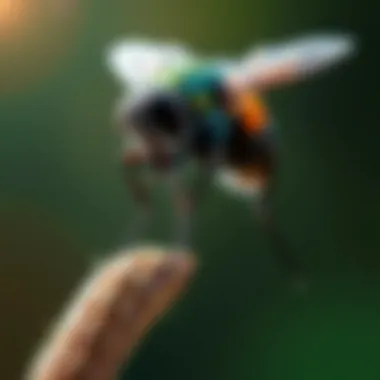Choosing the Best Fly Repellents for Your Home


Intro
The ever-present annoyance of flies during warm months can easily turn enjoyable moments into frustrating ones. Household pests often invade our spaces, bringing not just inconveniences but also potential health risks. Understanding how to combat these unwelcome visitors is essential for ensuring a safe and comfortable home environment. This article delves into effective fly repellents, from understanding the pests themselves to exploring preventative measures and treatment options.
By identifying the most common culprits, homeowners can take the necessary steps for effective fly control, ultimately improving their quality of life.
Pest Identification
Detailed descriptions of common pests
Flies come in various shapes and sizes, but a few types tend to infiltrate homes more than others. The most common offenders include house flies, fruit flies, and drain flies.
- House Flies: These pesky insects are easily recognizable by their grayish bodies and large red eyes. Often found buzzing around kitchens and garbage areas, house flies thrive in warm, moist environments.
- Fruit Flies: Small and tan or brown, fruit flies are often spotted near overripe fruit or fermenting substances. Their rapid breeding cycle allows them to cause significant nuisance if not dealt with promptly.
- Drain Flies: These tiny, fuzzy flies are dark gray or black and are commonly discovered fondly hovering near sinks or drains. They breed in stagnant water and can become a real headache once they settle in.
Signs and symptoms of infestations
Detecting a fly problem quickly is crucial. Some early warning signs include:
- Unexplained buzzing noises in rooms
- Finding these flies around food sources or rubbish bins
- Seeing a significant number of them in one area, such as near windows or doorways.
Recognizing these signs early can save homeowners time and effort in addressing the problem before it escalates into a full-blown infestation.
"Understanding the pests better can lead to more effective control measures, making the experience less daunting."
Prevention Strategies
Home maintenance tips for pest prevention
Preventing flies from entering homes is vital and often requires a combination of strategies. Here are some practical tips:
- Seal Entry Points: Inspect windows, doors, and any cracks in walls to ensure they are sealed properly. Use weather stripping and door sweeps as needed.
- Clean Regularly: Keeping areas clean reduces attractants. Ensure that food items are stored securely, and clean any spills promptly.
- Manage Waste: Dispose of trash regularly and use bins with tight-fitting lids to eliminate access to breeding grounds.
Natural deterrents and barriers
Incorporating natural solutions can be a game changer. Consider these deterrents:
- Herbs and Essential Oils: Plants such as basil, lavender, and mint have scents that repel flies. Placing pots of these herbs around your home can discourage them from entering.
- Vinegar Traps: For fruit flies, setting out bowls of vinegar can draw them in while trapping them effectively.
Adopting these strategies doesn’t just help control flies but also contributes to a cleaner living space.
Treatment Options
Overview of chemical vs. natural treatments
When it comes to addressing an established infestation, understanding treatment options is key. Chemical solutions, like insect sprays, often provide quick results but may carry potential health risks. On the other hand, natural methods tend to be gentler on the environment and safer for households, especially in homes with pets and kids.
Step-by-step guides for DIY treatments
For those inclined towards a hands-on approach, here are simple DIY methods:
- Soap and Water Spray: Mix liquid soap with water in a spray bottle, and apply it on flies directly to eliminate them.
- Apple Cider Vinegar Trap: Fill a jar with apple cider vinegar and cover it with plastic wrap. Poke small holes in the wrap. Flies will be lured in but unable to escape.
- Clove or Cinnamon Oil Spray: Combine several drops of these oils with water in a spray bottle and apply it around entry points.
With these straightforward methods, homeowners can regain control of their spaces effectively.
Understanding the Fly Problem
Understanding the fly problem is crucial for effectively combating these pests in our living spaces. Flies are not just annoying; they bring along a host of complications that can affect health, hygiene, and even peace of mind in the home. A thorough grasp of the type of flies that plague various environments—including homes, kitchens, and backyards—can inform strategies to mitigate their impact.
One of the most significant benefits of understanding the fly problem lies in recognizing the specific types of flies that can invade different settings. For instance, houseflies are ubiquitous, often found buzzing around kitchens and dining areas. In contrast, fruit flies tend to flock to overripe fruits and vegetables left uncovered on counters. Such knowledge can guide homeowners in choosing targeted repellents and prevention measures tailored to the unique behaviors of these pests.
Furthermore, exploring the fly problem sheds light on their lifecycle and breeding habits, which are critical facets that reflect how best to deal with them. For example, knowing that houseflies reproduce rapidly means swift action is necessary to prevent an infestation from snowballing.
In essence, understanding the fly problem is the cornerstone of successful fly management. It not only informs the choice of repellents but also assists in employing comprehensive strategies to create an unwelcoming environment for flies. By laying this groundwork, homeowners can make informed decisions, leading to effective fly control in and around their homes.
Types of Flies Commonly Encountered
When diving into the topic of flies, it is vital to familiarize oneself with the types of flies commonly found in residential areas. Here’s a brief overview of some of the most encountered species and their characteristics:


- Houseflies (Musca domestica): Easily recognizable, houseflies are grayish with four dark stripes on their thorax. They thrive in environments rich in organic matter, often found feasting on human food leftovers, pet waste, and decaying materials.
- Fruit Flies (Drosophila melanogaster): Small and brownish, fruit flies are notorious for invading kitchens, especially around ripe or fermenting fruits. Their ability to reproduce rapidly makes them a persistent nuisance.
- Drain Flies (Psychoda spp.): Also known as moth flies, these are small, fuzzy insects that are typically found near drains, sinks, and areas with stagnant water. They breed in organic debris accumulated in drains, posing both a hygiene risk and annoyance.
- Flesh Flies (Sarcophagidae): These flies are often drawn to carrion or waste products and are identifiable by their distinct gray or black color with three dark longitudinal stripes. Their presence indicates decomposition nearby, which can be alarming for homeowners.
Being aware of these types helps in recognizing specific fly problems even before they escalate. Targeted approaches can then be established, ensuring that the right prevention and control measures are put in place.
Impact of Flies on Health and Hygiene
Flies, though often overlooked, can significantly detract from health and hygiene in residential settings. Their mere presence can transform an otherwise serene home into a breeding ground for disease.
These pests are vectors for numerous pathogens. For instance, houseflies can carry bacteria such as Salmonella and E. coli, which they pick up from waste and waste-covered surfaces. When they land on food or food preparation areas, they can easily contaminate these surfaces, unwittingly transmitting diseases that can affect the whole family.
The impact of flies extends beyond immediate health risks. The psychological discomfort caused by the incessant buzzing and movement of flies can lead to increased stress in households.
Key Takeaways About Flies and Hygiene
- Flies are known carriers of bacteria and viruses that pose health risks.
- They can contaminate food and surfaces, leading to foodborne illnesses.
- Their presence can increase anxiety and discomfort in homes.
The overarching takeaway is that flies can compromise both health and hygiene, making it important for homeowners to adopt preventative measures. Understanding these impacts is a necessary step towards developing effective strategies for keeping flies at bay and ensuring a healthy living environment.
“An ounce of prevention is worth a pound of cure,” applying this proverb has never been more pertinent in managing the fly problem effectively.
By confronting the fly issue head-on, homeowners can create a healthier, more comfortable environment within their households.
The Science of Repellents
Understanding the science of repellents is crucial in effectively addressing the fly nuisance that plagues households and outdoor spaces alike. Repellents operate on the principle of deterrence—making the surroundings less inviting for flies, thereby helping maintain a hygienic environment. By exploring the underlying mechanisms of how these products work, individuals are better equipped to make informed decisions about which repellents will best suit their needs, whether they reside in a bustling urban area or a tranquil countryside.
How Repellents Work
Repellents function through various mechanisms to discourage flies from invading personal space. At the most basic level, they may mask or alter the scents that attract flies, throwing them off their usual path. The active ingredients in these products may irritate the sensory receptors of the flies, disrupting their ability to find food and breeding sites.
In chemical repellents, agents like DEET or picaridin operate by interfering with the receptors flies use to detect odors, making it harder for them to sense the presence of humans or animals. Conversely, natural repellents often rely on plant-derived oils, such as citronella or eucalyptus, which emit strong scents that flies find unpleasant and steer clear of.
"Many fly repellents work by creating an olfactory barrier, like a bouncer at an exclusive club, ensuring flies don’t get past the door."
Chemical vs. Natural Repellents
When weighing options, one must consider both chemical and natural repellents, as each category has its own set of advantages and drawbacks.
- Chemical Repellents: Known for their powerful efficacy, chemical repellents can provide long-lasting protection and are especially effective against various species of flies. Ingredients like DEET are often hailed for their high repelling success rate. However, the implications of using synthetic chemicals raise questions about safety, long-term health effects, and environmental impact. Users should be cautious and assess their specific sensitivities, especially in households with pets or children.
- Natural Repellents: On the other hand, natural repellents are generally perceived as safer for both human health and the environment. They are often made from essential oils and botanical extracts, which can be a preferable alternative for those with chemical sensitivities. However, the tradeoff might come in effectiveness and longevity of protection. For example, products with citronella require more frequent reapplication, as their scent dissipates faster.
Ultimately, the choice between chemical and natural options depends on the specific context—where you are using them, for how long you need the protection, and the particular preferences and sensitivities of you and those around you. An informed understanding of these differences can lead to smarter choices in fly control.
Chemical Repellents
Chemical repellents form a substantial part of the fly control conversation. Understanding them is vital because they often offer immediate and effective solutions to many fly-related nuisances. These repellents utilize synthesized compounds designed to deter flies, making them an appealing option for homeowners seeking quick fixes. Their effectiveness can often surpass that of natural alternatives, especially in areas heavily infested with flies. However, the use of such products raises important questions regarding safety, environmental impact, and individual preferences.
Overview of Common Chemical Ingredients
Chemical fly repellents contain specific active ingredients that have proven efficiency against various kinds of flies. Below are some common ingredients one might encounter:
- DEET (N,N-Diethyl-meta-toluamide): Widely regarded as a gold standard in repellent technology. Effective against mosquitoes and other pests, it's a favorite for outdoor enthusiasts.
- Picaridin: An emerging alternative to DEET, picaridin is effective against a variety of insects and has less odor compared to DEET, making it more user-friendly.
- Permethrin: Usually a topical treatment for clothing, this chemical repellent kills insects on contact and is often used in conjunction with other repellents.
- Lemon Eucalyptus Oil: While derived from a natural source, this oil is often processed chemically to enhance its repellent properties.
These ingredients, while effective, each carry their unique set of pros and cons that need consideration.
Effectiveness of Chemical Repellents
The effectiveness of chemical repellents can often be measured through specific metrics such as duration of protection and the range of pests targeted. For instance, DEET-based products can last for several hours, making them suitable for all-day outdoor events. Conversely, the efficacy of certain natural products usually diminishes relatively fast, sometimes within an hour or two.
"Understanding the action of these chemicals works wonders for making informed choices; paired with knowledge, homeowners can combat the fly epidemic more effectively."
Another key factor is the formulation of the product itself. Sprays are popular due to easy application, while other formats like lotions or creams may provide longer-lasting coverage. Additionally, the concept of a repellent's scent can influence its effectiveness. Some flies are attracted to certain odors—being mindful of these scents can increase the likelihood of repelling flies effectively.
Ultimately, consumers should weigh the effectiveness against their priorities, deciding what matters most: longevity, ease of use, or specific targeting.
Safety and Precautions
While chemical repellents offer impressive benefits, safety must not take a back seat. Here are key precautions to bear in mind when using these products:
- Skin Sensitivity: Always conduct a patch test when using a new product. Some individuals may experience skin irritations from prolonged use.
- Environmental Concerns: Be aware of how these chemicals affect local wildlife and ecosystems. Products with strong chemicals should not be used near water bodies to prevent contamination.
- Proper Storage: Keep repellents out of reach of children and pets. Many active ingredients, while safe in small doses, can be harmful if ingested.
- Follow Instructions: Always adhere to the manufacturer's guidelines regarding application methods, dosage, and recommended usage.


In summary, while chemical repellents are a robust option in the battle against flies, understanding their ingredients, effectiveness, and safety considerations will empower you to make prudent choices fitting your household needs.
Natural Repellents
Natural repellents have carved out a significant niche within the world of pest management. They not only offer a safer alternative to chemical-based solutions but also resonate with those looking for eco-friendly options. The interest in these organic solutions has surged in recent years, spurred by a growing awareness of health and environmental concerns. Understanding the role of natural repellents is crucial for households aiming to minimize their ecological footprint while effectively managing the pesky fly problem.
One key advantage of natural repellents is their typically lower toxicity levels. For families with pets or young children, using ingredients sourced from nature means you don’t have to worry as much about harmful side effects. Many natural repellents utilize essential oils, herbs, and other plant-derived substances known for their repellent properties. Additionally, they often present a more pleasant aroma compared to synthetic alternatives, contributing not just to pest control, but also enhancing indoor and outdoor ambiance.
However, the effectiveness of natural repellents can vary greatly depending on the formulation and method of application. Identifying the right combination of natural ingredients is therefore imperative to create a potent repellent.
Popular Natural Ingredients
Natural repellents rely on various ingredients that have stood the test of time regarding their effectiveness. Below is a selection of some widely recognized natural components:
- Peppermint Oil: Known for its refreshing scent, peppermint oil also acts as a strong deterrent for flies.
- Lavender: The calming aroma of lavender is not just soothing for humans – flies are quite put off by it!
- Cinnamon: Beyond its culinary uses, cinnamon has shown significant promise as a fly deterrent.
- Eucalyptus: The oil from eucalyptus not only smells nice but helps keep flies at bay.
- Vinegar: Though it has a strong odor, vinegar can attract certain pests while also repelling others when mixed with essential oils.
This list is just a starting point. Experimenting with different combinations can lead to effective homemade solutions tailored for specific environments.
DIY Natural Repellent Recipes
Creating your own natural fly repellent can be both fun and rewarding. Here are a couple of simple recipes that might serve you well in your quest to keep flies away:
Peppermint and Water Spray
Ingredients:
- 2 cups of water
- 10-15 drops of peppermint oil
Instructions:
- Mix the peppermint oil with water in a spray bottle.
- Shake well before each use.
- Spray around doorways, windows, and other entry points.
Lavender-infused Vinegar
Ingredients:
- 1 cup of white vinegar
- 1 cup of fresh lavender leaves
- Water
Instructions:
- Combine lavender and vinegar in a jar and let it sit in a cool, dark place for about a week.
- Strain the mixture and mix it with equal parts water.
- Use as a spray around the home and in food preparation areas.
Both recipes are straightforward and can yield great results without the worry of harmful chemicals.
Comparative Effectiveness of Natural vs. Chemical Options
When weighing natural repellents against their chemical counterparts, several factors come into play. Here’s a look at some of the aspects to consider:
- Effectiveness: Chemical repellents can often provide immediate results, but natural options may require a bit more time and frequent reapplication for optimal results.
- Safety: While many chemical repellents are effective, they can pose potential health risks, especially in spaces where food is prepped. Natural alternatives tend to be safer, making them preferable for homes with children or pets.
- Environmental Impact: Natural repellents are generally better for the environment. Chemical pesticides often disrupt local ecosystems and harm beneficial insects.
- Cost: Natural ingredients can sometimes be more cost-effective, particularly if you choose to make your own repellents from items already in your pantry or garden.
Ultimately, the decision between natural and chemical options boils down to personal preference and individual household needs. Both categories have their unique strengths and weaknesses, highlighting the importance of selecting the right product for the specific context of use.
By understanding the value and characteristics of natural repellents, homeowners can make informed choices that effectively address their fly problems while aligning with a more sustainable lifestyle. With a focus on using quality ingredients and effective recipes, fly management can become a more pleasant and less daunting task.
Evaluating the Best Repellents
When it comes to keeping flies at bay, not all repellents are created equal. Therefore, understanding how to evaluate the best ones can make a significant difference, especially for housewives and homeowners who aim for a comfortable living environment. Evaluating repellents involves looking beyond flashy packaging and catchy advertising. It's about examining effectiveness, safety, and suitability for individual needs. This section will cover several key factors to guide you in making an informed decision.
Factors to Consider When Choosing a Repellent
Selecting the right fly repellent requires careful thought and consideration. Here are some crucial elements to keep in mind:
- Fly Type: Different flies have specific traits. For instance, house flies respond differently to repellents than fruit flies. Identifying the fly species you are dealing with can lead to more effective repellent choices.
- Active Ingredients: The composition of the repellent can greatly impact its effectiveness. In chemical repellents, ingredients like DEET, Picaridin, or Permethrin are common. Natural options might include citronella, eucalyptus oil, or neem oil. Being aware of what’s in the products you choose is beneficial.
- Duration of Effectiveness: A repellent’s longevity is vital for busy households. Some products last several hours while others may need reapplication more frequently. Choosing one that fits into your lifestyle can save you a lot of hassle.
- Safety Concerns: For families, safety is paramount. Look for products that are EPA-approved or have undergone rigorous testing. Awareness of potential side effects, especially for children and pets, is essential.
- User Experience: Comfort matters. Some repellents might smell pleasant, while others could leave an oily residue. Such factors influence how often you'll want to use a repellent.
Consumer Reviews and Expert Recommendations
Alongside your research, tapping into the experiences of others can be invaluable. Here’s what to consider when evaluating reviews:
“Consumer insights often reflect real-world effectiveness and any unforeseen issues with a product.”
- Real-World Testing: Unlike lab results, consumer reviews give a realistic glance at performance. Make sure to look at reviews that specifically mention their fly situations. A homeowner's success story may resonate more than a generic endorsement.
- Expert Opinions: Many health departments and pest control experts provide recommendations based on studies and field experience. Their advice often comes with insights about the proper application and efficacy in reducing fly populations.
- Peer Sharing Platforms: Websites like Reddit (reddit.com) and Facebook groups are buzzing with discussions about different repellents. Tuning into these communication channels allows potential users to gather live testimonies, often presenting a mix of successes and difficulties faced by the everyday user.
In summary, evaluating the best repellents involves understanding your personal circumstances, actively researching product ingredients, and prioritizing consumer insights for informed decision-making. Each layer of knowledge aids in the ultimate goal: a fly-free home.


Practical Applications
Understanding how to effectively apply fly repellents in various settings is essential for achieving optimal fly control. Since flies can show up in the most inconvenient places, knowing where and how to use repellents can significantly impact a household's comfort and hygiene. With proper applications, homeowners can minimize infestation risks, maintain cleanliness, and protect their health and well-being. Let's delve into some specific settings where repellents can be particularly useful, discussing their attributes and unique features.
Using Repellents in Various Settings
Household
In the household, applying fly repellents is one of the primary lines of defense against pesky insects. The residential setting is where homeowners spend most of their time, and flies can pose both discomfort and health risks. One key characteristic of household repellents is their ability to deter flies without posing serious threats to those living in the space. The development of specialized formulations means that many household repellents are designed to be safe for use around children and pets, making them a popular choice for families.
A unique feature found in many household repellents is their ability to be used in combination with other cleaning products. For instance, sprays can often be applied after cleaning surfaces, ensuring that any existing flies or their eggs are effectively eliminated. However, there is a caveat: Homeowners should always read labels carefully to ensure that chemicals do not interact adversely with other cleaning agents. Despite this, household repellents provide an effective means of managing the fly problem right at home.
Outdoor Activities
When engaging in outdoor activities, such as picnics or camping, effective fly management is equally important as it can affect the enjoyment of those experiences. Outdoor repellents are specifically formulated to withstand the elements, making them suitable for extended use outdoors. Their purpose is to create a protective barrier that keeps flies at bay while participating in recreational activities.
The outdoor environment presents a unique challenge: flies can be attracted to food and odors, making it essential to select repellents that are designed to hold up against these attractants. Popular choices, like citronella candles or sprays, not only repel flies but also enhance the ambiance of outdoor gatherings. However, one must remember that the effectiveness of outdoor repellents can be diminished by strong winds or rain. Therefore, it’s wise to reapply these products periodically to maintain their potency. Ultimately, outdoor repellents are indispensable to promote pleasant and fly-free experiences outside.
Food Preparation Areas
In food preparation areas, managing flies is critical to ensuring food safety and hygiene. The presence of flies near food can lead to contamination and health risks, as flies can carry bacteria from waste to edible items. This highlights the need for effective repellents that are not only powerful but also safe for food environments.
One key aspect of repellents in food preparation areas is their formulation. Many products are designed to be non-toxic and safe for use in kitchens and restaurants, where food is handled. Unique features include the application of sprays that create a barrier around food items, warding off flies without affecting the airborne quality of the area. Though many repellents exist, it’s important to choose those with a reputation for safety and effectiveness. While repellents can help, preventive measures like ensuring surfaces are clean and food is stored correctly should also be prioritized. Thus, repellents for food preparation become a vital part of maintaining a healthy cooking environment.
Best Practices for Effective Use
To maximize effectiveness, certain best practices are worth emphasizing:
- Read labels carefully to ensure you're applying the product correctly.
- Consider the environment — both outdoor and indoor — to select the right formulation.
- Reapply repellents according to the product’s guidelines for optimum results.
- Combine repellents with sanitation practices, especially in food-prep areas, for a proactive approach.
Employing these strategies will help reinforce the repellent's effectiveness and enhance fly management across all settings.
Environmental Considerations
When dealing with fly repellents, one must not overlook the implications of their use on our environment. Similarly to how a fly can buzz annoyingly and disrupt daily life, the long-term effects of repellents can quietly impact our ecosystems. Understanding these considerations is crucial, as they help us make better choices that align with our health and ecological responsibilities.
Impact of Repellents on Ecosystems
The ingredients found in chemical repellents can have varied effects on different ecosystems. For example, certain synthetic compounds can lead to negative repercussions for beneficial insects like bees and butterflies. More importantly, when these chemicals are washed away into our soil and waterways, they can disrupt aquatic life.
Some specific concerns include:
- Toxicity Levels: Various repellents exhibit different levels of toxicity to non-target species. These toxins can accumulate in the food chain, affecting not just insects, but also birds and mammals.
- Soil Health: Over time, chemical runoff can impair soil quality, leading to decreased plant biodiversity. Healthy soil is vital for maintaining robust ecosystems.
- Water Quality: Contaminants from repellents can trickle into rivers and lakes, causing harmful algae blooms which deplete oxygen and harm aquatic species.
"The focus on effective fly control must not come at the cost of our ecosystems’ health. It’s a delicate balance to strike."
Addressing these issues is not just about protecting our immediate surroundings but ensuring future generations inherit a balanced ecosystem capable of supporting life.
Sustainable Alternatives and Approaches
Fortunately, there are various sustainable methods to keep flies at bay without compromising the ecosystem. These options often rely on natural ingredients that are generally safer for both humans and the environment. Here are some methods to consider:
- Natural Repellents: Ingredients like essential oils, vinegar, and herbs can provide effective protection without the toxic weight of chemicals.
- Physical Barriers: Screens, nets, and traps can physically keep flies away from areas where they are not wanted, effectively reducing the need for chemical intervention.
- Habitat Management: Keeping areas clean and free of standing water—a breeding ground for flies—can drastically reduce their populations. Regularly removing waste and properly storing food can also help.
- Organic Farming Practices: These involve avoiding synthetic pesticides entirely, relying instead on biological pest control techniques to naturally manage fly populations.
- For instance, using eucalyptus oil or citronella is a classic remedy for repelling flies.
In summary, as we look to address the nuisance of flies in our lives, it's vital to consider how our choices affect the environment. By opting for safer alternatives and managing habitats wisely, we can ensure that we not only protect our homes but also play a role in preserving the delicate balance of nature.
Culmination
Understanding and selecting the right fly repellent can considerably reduce your household’s fly problem, enhancing both comfort and hygiene. As we’ve discussed throughout this article, flies not only pose nuisance but can also be carriers of diseases that affect families. Therefore, targeting the fly issue efficiently is crucial.
Recap of Key Insights
Throughout this guide, we've explored a variety of insights pertinent to fly repellents. Here’s a nutshell overview:
- Types of Repellents: We differentiated between chemical and natural options, highlighting their unique properties and the settings in which they shine.
- Effectiveness & Safety: Evaluating different repellents isn’t only about how well they repel; it’s also about safety for families and pets. Knowing the ingredients helps in making informed decisions.
- Applications: Context matters. Whether you’re in a home environment, outdoor spaces, or food prep areas, the choice of repellent can differ significantly based on the surroundings.
- Environmental Factors: The impact on ecosystems shouldn't be overlooked. Choosing sustainable options is increasingly relevant for eco-conscious households.
Collectively, these aspects emphasize the multi-layered consideration needed when picking a repellent. It’s not just about a quick fix; it’s about long-term family health and environmental impacts.
Final Recommendations
To close, here are some essential tips to aid your decision:
- Assess Your Environment: Look at where you need to use repellents. Is it outdoors or indoors? Is there food around? Each scenario may require a different approach.
- Consider Family Needs: If you have young children or pets, lean toward natural options that minimize health risks.
- Read Reviews: Delve into consumer experiences. Look for products that have solid recommendations and proven effectiveness, perhaps on sites like reddit.com or product review aggregators.
- Stay Informed on Ingredients: Understanding what you’re dealing with helps you avoid potential allergens or harsh chemicals that could harm your household environment.
- Think Long-Term: Invest not just in immediate solutions, but in overall pest management strategies, including cleanliness and preventive measures like proper waste disposal.



